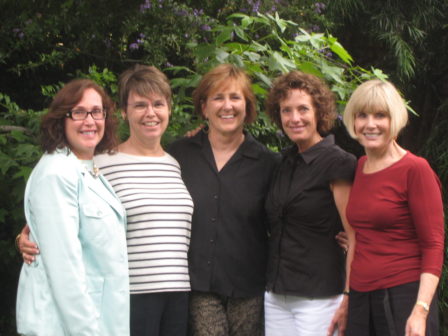Woman Power!
By Laura Walcher
When a San Diego Women’s Foundation (SDWF) member parts with $2,000 every year, strictly for community improvement, perks abound. Friendships that might never have been otherwise possible, and an immersion into society and its needs that somehow escaped one’s notice in the course of daily duties, family, friends and careers occurs.
Tracy Johnson (TJ), SDWF director, tells me these are the common experiences the dozens of women enjoy via their participation in the philanthropic organization.
We talked:
LW: What inspired the SDWF? Given the many contribution organizations – like the SD Foundation -what do you do differently?
TJ: In 2000, a small group of San Diego volunteers launched SDWF – envisioning an organization that would promote the participation and leadership of women in philanthropy. They recognized that women’s traditional patterns of giving were changing’ they were making more of the philanthropic decisions within their families. Still, philanthropy was uncharted territory for many. They founded the SDWF to strengthen our capacities to engage in significant giving in San Diego.
We weren’t only interested in ‘women’s’ issues. We wanted to affect the environment, economics of the region, issues of sustainability, and issues affecting education, the arts, health and human services.
Our founding principle is ‘pooled philanthropy’ – the belief that we can do far more together than we could ever do alone. When extraordinary women combine their resources of time, talent and funds, the community is changed in powerful and meaningful ways.
In these 11 years, our grants total $2.1 million, benefiting 58 programs across the county. We’ve benefited underserved and low-income communities, children, refugees and our minority/ethnic neighbors.
For instance, one grant resulted in 14,000 students attending a noted opera performance via the dress rehearsal; another, the construction of a green sea turtle exhibit, educating thousands about turtles found off our own coastline; and, another grant exposed hundreds of students to messages about gang violence prevention at school assemblies and workshops.
Many of our “grantee” organizations feel our influence for years. Example: the Alliance for African Assistance program was to train refugees and immigrants on medical/dental interpreting through a 10-week certification course, providing opportunities for well-paid employment. The SDWF materials and that reference library are still used for teaching many others, following a similar path.
Education is also key, and our forums are at our core. Members and guests interested in SDWF membership are invited to attend. Some programs have minimal costs; others are free.
LW: Do your choices of issues arise out of your members’ specific interests or do you research and identify unfilled needs?
TJ: Before we make our decisions, the “Discovery Team” researches community needs and priorities, interviews community leaders and listens to our members with the goal of narrowing the focus to those on which our dollars can make an impact.
LW: Your financial formula is simple? Members pay in, you pay out. No fund-raisers? No solicitations?
TJ: Each member commits to an annual contribution of $2,000 for a minimum of five years, and has one vote to determine where grants will be awarded each year. We are a no-guilt organization; members can do a little or a lot. Support from The San Diego Foundation, endowment earnings, and member contributions to the operating fund allow us to operate without fundraisers.
Considering a legacy to last beyond their lifetimes, we’ve determined that 45 percent of each member’s annual contribution be allocated to a permanent endowment fund, to benefit and strengthen our region far into the future.
Bottom line, our philosophy of “pooled philanthropy,” means each $2,000 really results in approximately $200,000 of grants.
LW: What are your main criteria for deciding on who/what to fund? Do you do post-mortems with funded organizations to evaluate the impact – or lack thereof – of the funding?
TJ: Criteria is specified for each grant, Then, our Impact Team serves as the liaison to all grantees to evaluate and track the effectiveness and success of our grants.
LW: How do you decide who gets what?
TJ: We invite grant proposals, reviewed by the team. We conduct site visits and determine which nonprofit programs will make it to our final ballot. It is a respected and rigorous process and nonprofits feel as though they have truly earned the funds when they are awarded a grant.
LW: In what areas of need have you made the most impact?
TJ: In our 11 years – all areas! We have helped children become the first in their families to go to college, inspired environmental ambassadors, supplied hundreds of meals to the elderly, provided homes for foster children, provided a creative outlet for at-risk youth, provided opportunities for people to be trained and secure jobs paying a living wage. You don’t need to be a millionaire to make a difference in thousands of lives.
LW: Who were your founding members?
TJ: One hundred women, about 40 percent are still involved. Naming a few, Linda Katz, founding president, Darcy Bingham, Alicia Foster, Carol Chang, Cindy Olmstead, Barbara Freeman, Darlene Shiley, Valerie Jacobs. Eileen Haag is our current president.
We always want new members. The application is on our website at www.sdwomensfoundation.org , or, I welcome phone calls: 619-814-1374.
LW: Why no men?
TJ: We absolutely welcome men who wish to support SDWF through charitable donations and support for the women in their lives who are involved.
Category: Life Style








